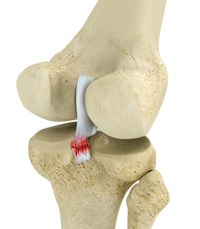PCL Injuries

What is Posterior Cruciate Ligament Injuries?
Posterior cruciate ligament (PCL), one of four major ligaments of the knee are situated at the back of the knee. It connects the thighbone (femur) to the shinbone (tibia). The PCL limits the backward motion of the shinbone.
PCL injuries are very rare and are difficult to detect than other knee ligament injuries. Cartilage injuries, bone bruises, and ligament injuries often occur in combination with PCL injuries. Injuries to the PCL can be graded as I, II or III depending on the severity of injury. In grade I the ligament is mildly damaged and slightly stretched, but the knee joint is stable. In grade II there is partial tear of the ligament. In grade III there is complete tear of the ligament and the ligament is divided into two halves making the knee joint unstable.
Causes of PCL Injuries
The PCL is usually injured by a direct impact, such as in an automobile accident when the bent knee forcefully strikes the dashboard. In sports, it can occur when an athlete falls to the ground with a bent knee. Twisting injury or overextending the knee can cause the PCL to tear.
Symptoms of PCL Injuries
Patients with PCL injuries usually experience knee pain and swelling immediately after the injury. There may also be instability in the knee joint, knee stiffness that causes limping, and difficulty in walking.
Diagnosis of PCL Injuries
Diagnosis of a PCL tear is made based on your symptoms, medical history, and by performing a physical examination of the knee. Other diagnostic tests such as X-rays and MRI scan may be ordered. X-rays are useful to rule out avulsion fractures wherein the PCL tears off a piece of bone along with it. An MRI scan is done to help view the images of soft tissues better.
Treatments for PCL Injuries
Treatment options may include nonsurgical and surgical treatment. Nonsurgical treatment consists of rest, ice, compression, and elevation (RICE protocol); all assist in controlling pain and swelling. Physical therapy may be recommended to improve knee motion and strength. A knee brace may be needed to help immobilize your knee. Crutches may be recommended to protect your knee and avoid bearing weight on your leg.
Generally, surgery is considered in patients with dislocated knee and several torn ligaments including the PCL. Surgery involves reconstructing the torn ligament using a tissue graft which is taken from another part of your body, or a cadaver (another human donor). Surgery is usually carried out with an arthroscope using small incisions. The major advantages of this technique include minimal postoperative pain, short hospital stay, and a fast recovery. Following PCL reconstruction, a rehabilitation program will be started that helps you resume a wider range of activities. Usually, a complete recovery may take about 6 to 12 months.
Posterior Cruciate Ligament Injuries in Children
Posterior cruciate ligament injuries most often occur in children who participate in high-speed sports, such as basketball and soccer. These injuries occur more commonly in teenagers than in younger children. Often, in children younger than the age of 12, the bone where the PCL attaches breaks off. As PCL injuries commonly occur through traffic and industrial accidents, the incidence of these injuries is very low in children.
Surgery is not usually necessary to treat PCL injuries but if an injury displaces the piece of bone with the PCL, your child may have surgery to reattach it again.
The outcome of the treatment is dependent on age factor. Younger children may develop arthritis symptoms later in their life if surgical treatment is not given. In adults' surgery involves PCL reconstruction, however in children this surgery is still under controversy because of a risk of developing physeal (growth plate) injury. Growth plate also called as the epiphyseal plate or physis is the area of growing tissue made up of cartilage (rubbery material) found at the ends of the long bones in children.








